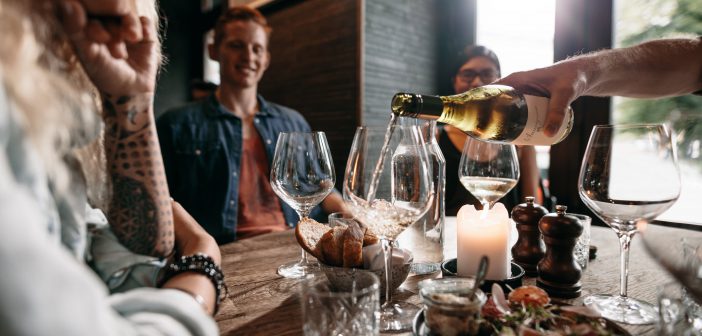Training your managers and staff about wine can take customer service to the next level.
ALESSANDRA ESTEVES, DipWSET, MAES
Peak season will present the hospitality industry with many great opportunities, as well as many challenges. One of the most significant challenges that many hotels and restaurants face is staff training. At the Wine & Spirit Education Trust (WSET), we believe the best way to improve employees’ ability to do their jobs is through education. To help with this challenge, we have put together a quick guide on how to educate your staff about wine and wine service.
Start with the basics
Managers may assume employees have a basic knowledge of wine since a large percent of the public enjoys drinking, but this is not always true. Start the training with the basics, such as main grape varietals. Educate the staff on the grapes’ standard aromas and flavor profile while keeping in mind that the style of the grape will be different depending on the region where it is grown and how it is vinified.
For white grapes, this includes chardonnay, sauvignon blanc and riesling.
Chardonnay – This varietal’s profile can change vastly depending on where it is grown. When from Chablis, France, it can be very pure and mineral. On the other hand, a chardonnay from Napa Valley can be complex, buttery and full-bodied.
Sauvignon Blanc – This wine tends to be fruity with herbaceous aromas, such as green bell pepper or grass. Wines coming from New Zealand will be fresh and dry with many tropical fruits, whereas sauvignon blanc wines from the Loire Valley in France can be more austere with green fruit aromas.
Riesling – Regularly considered to be one of the world’s greatest grape varietals, riesling is often misunderstood. Not all rieslings are sweet. There are many different styles of this noble grape produced all over the world. Be sure to train your staff on the styles you offer on your wine list. Are they dry, off-dry, medium sweet or lusciously sweet? This information is priceless for food and wine pairing.
As for red wines, you should familiarize your staff with cabernet sauvignon, pinot noir and merlot grapes.
Cabernet sauvignon – A big, bold and powerful varietal, it is favored by many consumers. Cabernet should be paired with robust dishes, such as steak, game or mushrooms. The first rule of food and wine pairing is to observe the intensity of flavors in the wine and the food. Neither one should overpower the other.
Pinot Noir – A grape with very thin skin, pinot noir produces wines with light color and low tannins. It is a perfect wine to pair with fish such as salmon and tuna, as an alternative to white wine.
Merlot – This varietal produces round, smooth and easy-drinking wines. Some people call it “cabernet sauvignon without the pain.” If you have a table where one customer likes cabernet sauvignon, and another enjoys pinot noir, you can play it safe by offering them a bottle of merlot.
Excel in wine service
Wine service is important to the success of any hotel or restaurant. Failure to provide excellent service can result in a negative dining experience for the customer. First, instruct your staff to look at the label carefully! Is this the wine your client ordered? Second, while pouring the wine, make sure the label faces the client at all times. After serving, keep the wine on the client’s table or in an ice bucket close to the table, as this prevents other servers from pouring the wine to the wrong table.
Highlight your hotel’s style
As a manager and sommelier, it is essential to keep in mind the style and cuisine of the hotel or restaurant when curating a wine list. When customers visit a steak house, they are expecting a wine list with full-bodied red wines, so keep the whites and rosés to a minimum.
An Italian restaurant should have a wine list with Italian labels to complement their regional foods. Training your servers beforehand by discussing the wines and how to pronounce them will improve customer service and raise self-esteem among your staff.
Another example is Japanese cuisine. Today, Japanese restaurants have dishes from the delicate sashimi to the more savory teppanyaki, made with meat and vegetables. The beverage list can have sake, ranging from the fruity sparkling sake, the lactic and cereal jumna, to the more floral daiginjo. It is helpful that your staff know the main differences between these styles. The wines for a Japanese restaurant should be refreshing and high in acidity to balance the spice of the cuisine, such as rieslings and sparkling wines. Fruity reds are an excellent choice to pair with meat dishes, too.
Consider location
Is your hotel located in the Caribbean or are you in the middle of snowy mountains? The guest will drink different wines, depending on the weather and the type of stay he or she is having.
An island vacation calls for beautifully crafted cocktails and light and refreshing whites and rosé wines. In this case, your wine list should include prosecco, cava, franciacorta and champagne, of course! Dry rosé wines are also becoming more popular, and they are the perfect choice when guests want to drink wine that has more flavor than a white and less body than a red. Light reds such as pinot noir and Beaujolais from France, with low levels of tannins, can also be great wines for summer vacation.
A ski resort, on the other hand, can offer powerful wines that will warm up guests and their hearts. Wines made with cabernet sauvignon, shiraz and Grenache-based wines like chadeayne du Pape are the wines to have on the list. Complex champagnes such as the vintage champagne can be an option as well.
Master Food and Wine Pairing
Food and wine pairing can be challenging to managers and servers (and is one of the most fascinating topics discussed during the WSET Level 1 course). While it is applicable on a daily basis, this is where people have the most difficulties.
The ingredients in food are usually the main culprit of poorly selected food and wine pairings. Therefore, it is better to pay close attention to the various food components.
Salt & Acid – In food, salt and acid are friends with wine. Normally red wines will seem less tannic and more palatable with salty dishes, and wines will appear to be fruitier with foods high in acids, such as tomato or lemon sauce.
Sweetness & Umami – Keep in mind when pairing, that sweetness and umami are wine enemies! Chocolate, for instance, pairs well with port or coffee. If you try to pair chocolate with any other wine, the wine will taste bitter and seem less fruity.
Educating your mangers and servers can improve their job competency, increasing employee retention by advancing staff satisfaction, and it certainly increases the profitability of a business. The better informed your employees are, the better they will perform.
Alessandra Esteves is a wine specialist at The Wine & Spirit Education Trust (WSET). WSET’s Level 1 Award in Wines, Spirits or Sake offers a hands-on introductory course, which can help your hotel staff learn about wine and wine and food pairing. For more information, visit wsetglobal.com.




